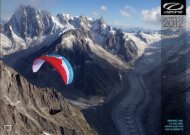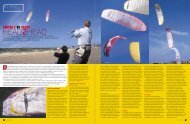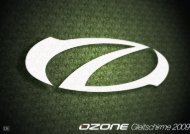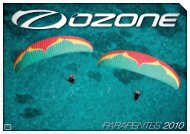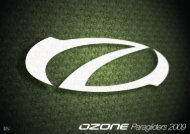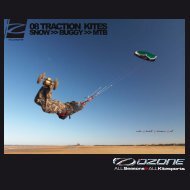PILOT'S MANUAL MANUEL DE VOL - Ozone
PILOT'S MANUAL MANUEL DE VOL - Ozone
PILOT'S MANUAL MANUEL DE VOL - Ozone
Create successful ePaper yourself
Turn your PDF publications into a flip-book with our unique Google optimized e-Paper software.
DRAG INDUCERS (BIG EARS)<br />
Folding in the tips increases the sink rate of your glider. This is useful for staying<br />
out of cloud or descending in strong winds. You 'pull big ears' by drawing in the<br />
outermost A-lines until the tips of the wing fold under and drag behind. OZONE<br />
gliders are fitted with split A-risers to make this procedure easy.<br />
To increase the sink rate further the accelerator bar may be employed, but pull<br />
the tips in first. Remember that when the tips are in, you have reduced the area<br />
of wing supporting you, so your stall speed will have increased. Be sure to keep<br />
speed on and not to use the brakes other than cautiously for reinflation. For directional<br />
control while using the drag inducers, you should rely on weight shift alone.<br />
To reopen the wing tips, release the small A-risers. Normally the tips will reinflate<br />
automatically, but you can help the process by careful use of the brakes. This is<br />
best done one tip at a time to minimise the chance of inducing a stall. You will find<br />
that there is surprisingly little tendency for the glider to deviate during the process.<br />
CAUTION: Do not use Drag Inducers near the ground.<br />
B-LINE STALL<br />
B-stall is used for fast descents in emergency situations only. B-stall is performed<br />
by symmetrically pulling down on the B-risers. This takes quite a lot of effort. The<br />
best way to do this is to place your fingers between the lines above the maillons<br />
at the top of the risers. You should not release the brake handles while B-stalling.<br />
As you first pull the B-lines down the airflow over the wing is broken and the glider<br />
loses its forward speed but remains open. By pulling the B-risers further the<br />
sink rate can be increased as the chord is effectively reduced.<br />
To exit the B-stall the B-risers should be returned to their normal flight position<br />
symmetrically in one smooth progressive motion. The glider should then resume<br />
normal forward flight without further input. Always be sure of this before using the<br />
brakes again.<br />
It is possible for the wing to resume its normal shape on release of the B-lines,<br />
but to remain in steep descent without full forward motion. This is called 'deep<br />
stall'. It is unlikely to happen on OZONE gliders, but you should be aware of the<br />
possibility. If you suspect it has happened, simply push the A-risers forwards until<br />
normal flight returns. Only then should you use the brakes again.<br />
13




